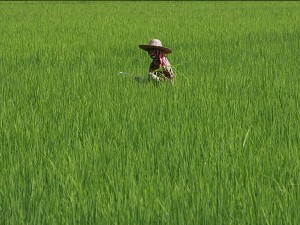Thai rice subsidy scheme to push up world prices

A Thai farmer cuts grass at her rice field in Fang district, Chiang Mai province, northern Thailand. Thailand's plan to pay its rice growers far above market rates is expected to push up prices for the staple that feeds almost half the world's people as rice importing nations look to other countries for tightened supplies. AP
BANGKOK—Thailand’s plan to pay its rice growers far above market rates is expected to push up prices for the staple that feeds almost half the world’s people as rice importing nations look to other countries for tightened supplies.
A new government in Thailand, the world’s biggest rice exporter, has promised growers higher prices for rice in a scheme that will take effect October 7. It’s putting no limit on the amount of rice it will buy.
What’s good for Thai farmers, who have long complained of being shortchanged by middlemen, is proving less popular elsewhere in Asia. The effects of the rice policy are rippling through the region, where many countries are already struggling with fast rising food prices.
Thailand’s rice exporters say they will ship less overseas because they will be unable to compete with the price the government pays. That in turn will tighten the global rice market, forcing up the staple’s price in other countries.
The US Department of Agriculture forecasts that Thailand’s rice exports will drop 20 percent to 8 million metric tons in 2012 because of the rice buying scheme. That could see Vietnam overtake Thailand as the No. 1 exporter.
Article continues after this advertisement“The rice prices in the global market will definitely escalate, since the supply from Thailand, the biggest exporter, is seeing a downturn,” said Witchuda Chummee, an analyst at Siam Commercial Bank’s Economic Intelligence Center in Bangkok.
Article continues after this advertisement“Using the Thai prices as a benchmark, other countries, like Vietnam, will likely increase their prices also.”
The Pheu Thai Party that swept to power in July 3 elections has said the government will pay farmers baht 15,000 ($500) per ton for unmilled paddy rice and baht 20,000 ($665) for unmilled jasmine rice. Before the election, unmilled paddy rice sold for baht 8,150 ($271) a ton and milled paddy rice sold for baht 13,000 ($432) a ton.
What’s causing particular angst for exporters is that the government intends to buy as much rice directly from growers as they want to sell.
“We will take as much as we can,” Commerce Minister Kittirat Na-Ranong told The Associated Press.
Chookiat Ophaswongse, the honorary president of the Thai Rice Exporters Association, said the international price for “white rice 5 percent” — long grain white rice with a 5 percent broken rice component — could reach $830 per ton “as soon as the scheme is fully implemented,” compared with the current market price of $613 per ton.
“The government’s price is too high and will definitely undermine the nation’s competitiveness in rice exporting,” said Chookiat. “If exporters cannot compete with the subsidized price, they may have to switch to trade rice of other origins.”
Elsewhere in Southeast Asia, Thailand’s move has underlined the importance of boosting local production and having a broad range of possible sources.
“This just shows how correct we are in pushing for self-sufficiency,” said Proceso Alcala, Agriculture Secretary for the Philippines, which is the world’s top rice importer.
The country’s National Food Authority is assessing likely demand for rice from other Southeast Asian countries for 2012 and subsequent years to get a clearer picture of whether Thailand can maintain high prices or if “natural market forces will also get them to reconsider the plan,” said its administrator Lito Banayo.
Banayo said if local rice growing targets are met, the Philippines would need to import only a million tons or less for 2012 — about the same amount bought for this year’s stocks.
Sutarto Alimoeso, chief of Indonesia’s state logistics agency, said the Thai scheme is a challenge to Indonesian farmers to improve their productivity.
The agency known as Bulog is currently importing 300,000 tons from Thailand and 500,000 tons from Vietnam for stockpiles, Alimoeso said.
In anticipating higher rice prices, Alimoeso said Indonesia is arranging possible imports from India and Pakistan. Imports from Myanmar and Cambodia are also an option.
Thailand first introduced a rice subsidy scheme in 2004 during the government of Thaksin Shinawatra, who was ousted in a coup two years later following prolonged protests in the capital Bangkok against his alleged corruption and CEO-style rule. The scheme was criticized for graft and its high cost.
Kittirat, the Thai Commerce Minister, told lawmakers last month that the rice scheme is expected to cost less than baht 100 billion ($3.32 billion) a year and will result in losses for the government of less than baht 10 billion ($332 million) a year.
A 2010 study by Thailand Develop Research Institute, a nonprofit think tank in Bangkok, found that the earlier rice buying program caused losses of baht 19.1 billion ($628 million) for the government in 2005. It said the program was “plagued with corruption at all stages” and that most of the benefits did not go to the farmers.
The latest plan, however, enjoys strong support from farmers, whose votes helped Pheu Thai, led by Thaksin’s younger sister Yingluck Shinawatra, win government with a strong parliamentary majority in July elections.
“This program directly benefits Thai farmers. We will no longer be taken advantage of by middlemen,” said Wichien Puanglumjiak, a representative of the farmers’ network in central Thailand.